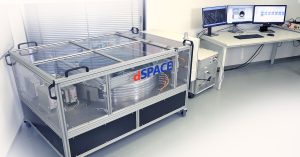AB Dynamics, a leading provider of automotive test solutions, has launched a major update to its Track Applications Suite. This comprehensive software ecosystem is specifically designed for the testing and validation of advanced driver assistance systems (ADAS). The latest update introduces over 400 new pre-defined active safety test scenarios to its extensive library, aligning with a variety of industry-standard protocols including CNCAP and UNECE.
This enhanced library now includes 237 tests tailored for the 2024 CNCAP protocols, 60 tests for the upcoming EU General Safety Regulation set to take effect in July, and 120 tests for UNECE protocols, covering the latest requirements for heavy vehicles. These additions underscore AB Dynamics’ commitment to supporting the evolving needs of the automotive industry and ensuring compliance with the latest safety standards.
Joel Blyth, lead application engineer at AB Dynamics, highlighted the widespread use of the Track Applications Suite among customers, including NCAP-affiliated laboratories. “Our Track Applications Suite serves as a primary verification tool for many of our clients,” Blyth explained. “The same software and resultant data are also crucial for our hardware products’ submissions for Euro NCAP approval.”
The extensive library of pre-defined scenarios is engineered to streamline development processes by allowing test engineers to automate the creation, setup, variation, execution, and verification of active safety protocols. This automation significantly reduces the time and effort required to develop new test scenarios and validation strategies, enhancing overall efficiency.
The Track Applications Suite integrates various software applications essential for managing tests and controlling robot-driven vehicles and ADAS targets. It can precisely calculate the location, trajectory, and speed of vehicles under test, as well as other objects. This capability ensures that scenarios are automatically adjusted to account for different vehicle dimensions, thereby guaranteeing accurate control of collision points in line with specific test requirements.
One of the standout features of the updated suite is the Scenario Generator tool. This tool allows engineers to visualize expected collision points by overlaying paths before initiating tests. This pre-test visualization enhances the accuracy and reliability of the testing process. Additionally, the Post Processor application is designed to deliver instant pass/fail results, further improving the efficiency of the test validation process.
A notable new feature called Move to Point has been introduced to enhance safety and efficiency on the test track. This feature automatically repositions test objects to new starting points at the end of each test. By ensuring that objects are correctly positioned for subsequent tests, Move to Point minimizes setup time and potential human error, thereby improving the overall testing workflow.
Blyth emphasized the importance of this update for automotive manufacturers aiming to sell vehicles globally. “Manufacturers must conduct and pass hundreds of active safety tests to meet the requirements of various regulatory and consumer bodies for every vehicle model they produce,” he said. “This process can be incredibly time-consuming and costly. Our end-to-end test solution automates much of this work, significantly reducing the time engineers spend on generating new scenarios and developing validation strategies.”







